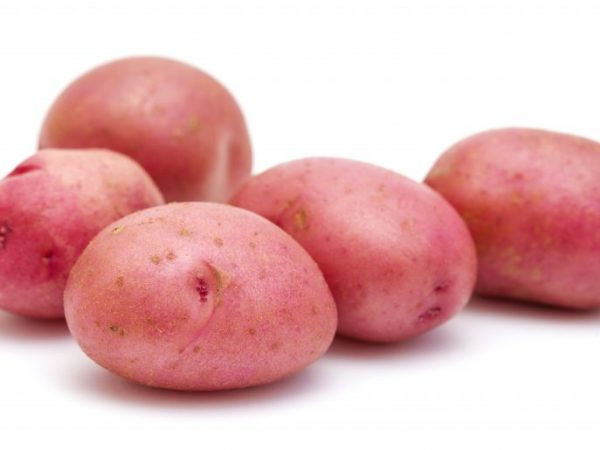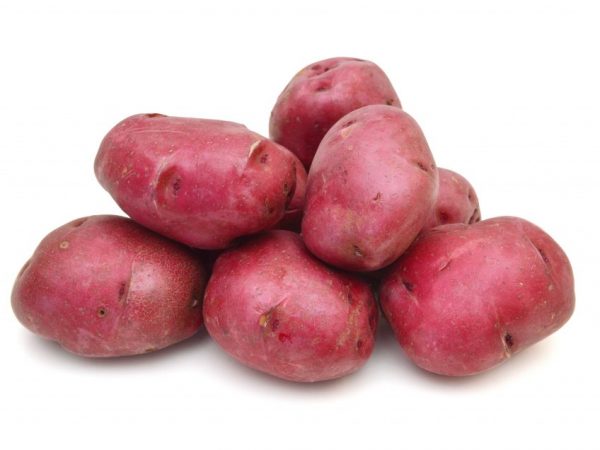Description of Rosalind potatoes
Rosalind potatoes belong to the category of industrial table varieties. Due to its taste and high yields, this type of tuber quickly gained popularity among gardeners and farmers around the world.

Description of Rosalind potatoes
Advantages of the variety
Like any other variety of tuberous Rosalind, it has both advantages and disadvantages. The advantages and features of this species include the following characteristics:
- Unpretentiousness to care. Rosalind is an ideal choice for commercial cultivation, as it does not require frequent watering and one hilling is sufficient for field cultivation.
- Taste qualities of tubers. Young tubers of Rosalind potatoes have a delicate taste and boil well. The fruits do not lose their unique taste throughout the entire shelf life.
- The high level of starch in the tubers makes this variety a versatile raw material for the industrial production of semi-finished products, chips, dry potato powders, and table starch.
- A generous harvest. This type of tuberous is distinguished by high yields per hectare.
- Thick skin. The dense skin allows transporting tubers over long distances and increases the keeping quality of the crop.
- Resistant to most types of tuberous diseases. The variety shows high resistance to potato crayfish, nematode, late blight.
disadvantages
But the characteristic of the variety will be incomplete, if not to mention its disadvantages:
- The variety is susceptible to pest attacks. Rosalina is a special potato, but it requires handling of the Colorado potato beetle, golden nematodes and wireworms.
- Too clayey or too sandy soil. Such soils can negatively affect the yield and quality of tubers.
- Many analogs. Sorts that have identical external features with Rosalind, but do not have its advantages, enter the market.
But, despite some shortcomings, this species deserves a reputation as one of the best tuberous varieties. Proper care of this plant will always guarantee high yields.
Planting potatoes
Description and characteristics of the Rosalind variety recommends planting tubers in mid or late April. It is advisable to fertilize the soil in advance on the site for planting and germinate the tubers a month before planting. Seed preparation begins with the selection of potatoes, damaged or rotten tubers are not suitable for planting. Having chosen potatoes, you need to put it in a dark, not cold place.
You can feed the soil with organic fertilizers. To do this, chicken droppings are bred with warm water and abundantly moisten the soil for the future garden.
Potatoes are planted to a depth of 6-8 centimeters. It is best to use a square-bush planting scheme. The distance between the bushes is 30-40 cm. This distance will provide comfort when caring for the bushes.
Potato care

Doesn't need careful maintenance
As mentioned earlier, Rosalind potatoes do not require much maintenance. This plant adapts well to different soils and can withstand temperature extremes and rapid weather changes. But, nevertheless, like any other variety, this one requires weeding and hilling. The first weeding can be done 10 days after planting, when the first leaves just appear above the ground. This will help keep the plants from getting stuck by weeds.
The second weeding and at the same time the first hilling of the bushes is carried out three to four weeks after planting. By this time, the bushes will already be high enough and the stems will be fully formed. The second hilling should be carried out after another two weeks, when the plant enters the period of tuber formation.
Pest control
Experienced farmers and gardeners are advised to carry out the first treatment from the invasion of pests even before the Colorado potato beetle begins its invasion. It is best to do this two weeks after disembarkation.
For spraying, it is best to use drugs such as:
- Prestige - due to the fact that imidacloprid and pencycuron are present in this product, it not only destroys pests, but also protects the plant from soil parasites and fungal diseases.
- Taboo is a relatively new drug. It has proven itself well as a means of protection against insect pests (wireworm, Colorado beetle).
- Aktara is the safest treatment for potato bushes. The drug quickly penetrates the leaves and stems of tuberous, making them poisonous to pests. But, it does not affect the tubers themselves.
- Fitoverm - belongs to the category of enteric-contact drugs against pests. It is maximally safe for the plant and can be used at any stage of crop growth.
This is not the whole list of effective remedies for the Colorado potato beetle. Which drug to give preference is decided by the gardener himself, based on the degree of infection of the bushes and the conditions in which the potatoes grow.
Conclusion
The Rosalind potato variety can stay in the soil until the very frost, but it is best to harvest in late autumn before the period of heavy rains and the first frost. Before you define the tubers for storage in a cellar or warehouse, you need to let them dry well. In addition, for better preservation of the crop, it is necessary to inspect the potatoes, remove tubers damaged during the digging process.


